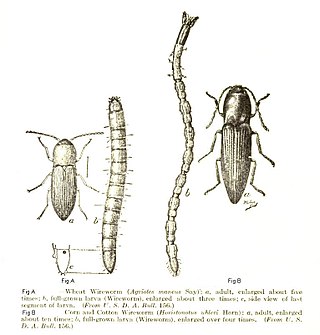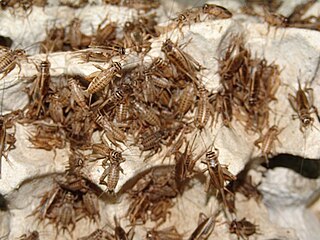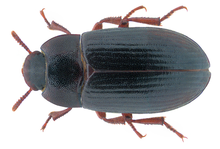
Beetles are insects that form the order Coleoptera, in the superorder Holometabola. Their front pair of wings are hardened into wing-cases, elytra, distinguishing them from most other insects. The Coleoptera, with about 400,000 described species, is the largest of all orders, constituting almost 40% of described insects and 25% of all known animal species; new species are discovered frequently, with estimates suggesting that there are between 0.9 and 2.1 million total species. Found in almost every habitat except the sea and the polar regions, they interact with their ecosystems in several ways: beetles often feed on plants and fungi, break down animal and plant debris, and eat other invertebrates. Some species are serious agricultural pests, such as the Colorado potato beetle, while others such as Coccinellidae eat aphids, scale insects, thrips, and other plant-sucking insects that damage crops.

Elateridae or click beetles are a family of beetles. Other names include elaters, snapping beetles, spring beetles or skipjacks. This family was defined by William Elford Leach (1790–1836) in 1815. They are a cosmopolitan beetle family characterized by the unusual click mechanism they possess. There are a few other families of Elateroidea in which a few members have the same mechanism, but most elaterid subfamilies can click. A spine on the prosternum can be snapped into a corresponding notch on the mesosternum, producing a violent "click" that can bounce the beetle into the air. Clicking is mainly used to avoid predation, although it is also useful when the beetle is on its back and needs to right itself. There are about 9300 known species worldwide, and 965 valid species in North America.

Mealworms are the larval form of the yellow mealworm beetle, Tenebrio molitor, a species of darkling beetle.

Darkling beetle is the common name for members of the beetle family Tenebrionidae, comprising over 20,000 species in a cosmopolitan distribution.

Histeridae is a family of beetles commonly known as clown beetles or hister beetles. This very diverse group of beetles contains 3,900 species found worldwide. They can be easily identified by their shortened elytra that leaves two of the seven tergites exposed, and their geniculate (elbowed) antennae with clubbed ends. These predatory feeders are most active at night and will fake death if they feel threatened. This family of beetles will occupy almost any kind of niche throughout the world. Hister beetles have proved useful during forensic investigations to help in time of death estimation. Also, certain species are used in the control of livestock pests that infest dung and to control houseflies. Because they are predacious and will even eat other hister beetles, they must be isolated when collected.

Dermestidae are a family of Coleoptera that are commonly referred to as skin beetles. Other common names include larder beetle, hide or leather beetles, carpet beetles, and khapra beetles. There are over 1,800 species described.

Zophobas morio is a species of darkling beetle, whose larvae are known by the common name superworm, kingworm, morio worm or simply Zophobas. Superworms are common in the reptile pet industry as food, along with giant mealworms, which are Tenebrio molitor larvae sprayed with juvenile hormone.

Tenebrio obscurus, or the dark mealworm beetle, is a species of darkling beetle whose larvae are known as mini mealworms. These insects should not be confused with younger mealworms or with the confused flour beetle.

Zophobas is a genus of beetles in the family Tenebrionidae, the darkling beetles. They occur in the Americas, from the Neotropics into southernmost United States. In Cuba beetles of this genus are known as blind click-beetles.

The confused flour beetle, a type of darkling beetle known as a flour beetle, is a common pest insect known for attacking and infesting stored flour and grain. They are one of the most common and most destructive insect pests for grain and other food products stored in silos, warehouses, grocery stores, and homes.

Tenebrioninae is the largest subfamily of the darkling beetles (Tenebrionidae), containing flour beetles, among others. Tenebrioninae contains more than 20 tribes.

Insect farming is the practice of raising and breeding insects as livestock, also referred to as minilivestock or micro stock. Insects may be farmed for the commodities they produce, or for them themselves; to be used as food, as feed, as a dye, and otherwise.

Typhaea stercorea is a cosmopolitan species of beetle of the family Mycetophagidae, known by the common name hairy fungus beetle.

Insects as food or edible insects are insect species used for human consumption. Over 2 billion people are estimated to eat insects on a daily basis. Globally, more than 2,000 insect species are considered edible, though far fewer are discussed for industrialized mass production and regionally authorized for use in food. Many insects are highly nutritious, though nutritional content depends on species and other factors such as diet and age. Insects offer a wide variety of flavors and are commonly consumed whole or pulverized for use in dishes and processed food products such as burger patties, pasta, or snacks. Like other foods, there can be risks associated with consuming insects, such as allergic reactions. As commercial interest in insects as food grows, countries are introducing new regulatory frameworks to oversee their production, processing, marketing, and consumption.

Cerotoma trifurcata is a species of beetle in the Chrysomelidae family that can be found in the Eastern and West United States.
Acarophenacidae is a family of mites in the order Trombidiformes that are egg parasitoids and ectoparasites of beetles or thrips. It contains eight genera and around 40 species.

Tribolium is a genus of flour beetles in the family Tenebrionidae. They are known by various common names including flour beetles, flour weevils, red weevils and bran bugs.

Dermestes ater is a species of beetle in the family Dermestidae, the skin beetles. It is known commonly as the black larder beetle or incinerator beetle. It is native to North America, but today it is found nearly worldwide. Like several other dermestid beetles, this species is a common pest of stored products.

Alphitobius laevigatus, the black fungus beetle, is a species of darkling beetle in the family Tenebrionidae. It is found in Europe and North America.

Alphitobius is a genus of darkling beetles in the family Tenebrionidae. There are about 18 described species in Alphitobius.




















